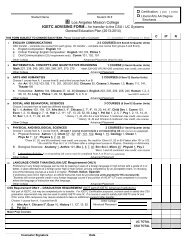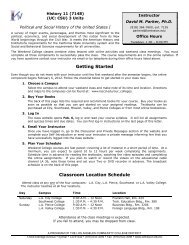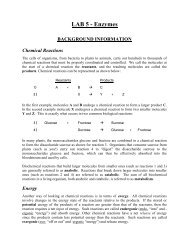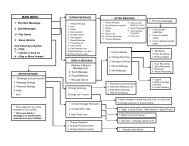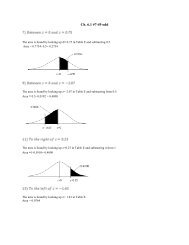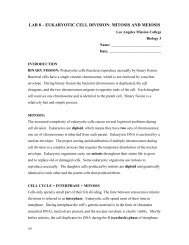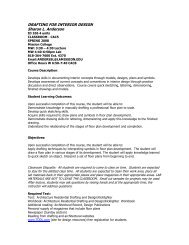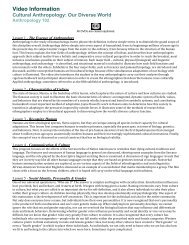Lab #3
Lab #3
Lab #3
Create successful ePaper yourself
Turn your PDF publications into a flip-book with our unique Google optimized e-Paper software.
Notice that a prokaryotic cell does not have any distinct internal compartments. This does not<br />
mean that prokaryotic cells have no internal organization, they simply do not have any<br />
structures we refer to as organelles. In contrast, animal and plant cells contain a variety of<br />
organelles. Take a moment to review the functions of the various cell structures and organelles<br />
shown and then complete the next exercise on your worksheet:<br />
STRUCTURE/ORGANELLE<br />
plasma membrane<br />
cell wall<br />
capsule<br />
flagellum<br />
nucleus<br />
endoplasmic reticulum<br />
Golgi apparatus<br />
mitochondria<br />
chloroplast<br />
central vacuole<br />
centrioles<br />
ribosomes<br />
FUNCTION<br />
barrier between inside/outside of cell<br />
extracellular structure that protects and supports cell<br />
protective gelatinous outer layer of some prokaryotes<br />
large cellular extension used for motility<br />
organelle containing the genetic material (DNA)<br />
synthesis of lipids, proteins in “secretory pathway”<br />
modification, sorting of “secretory pathway” proteins<br />
organelle in which cellular respiration occurs<br />
organelle in which photosynthesis occurs<br />
storage of water and other materials in plant cells<br />
structures involved in animal cell division<br />
small structures that carry out protein synthesis<br />
Exercise 3A – Review of cellular structures and organelles<br />
1) Fill in the correct labels for each cell diagram on your worksheet.<br />
2) Complete the matching exercise on your worksheet relating each cell structure and organelle<br />
with its function in cells.<br />
3) Fill in the chart on your worksheet indicating which structures and organelles are found in which<br />
cell types.<br />
Now that you are well acquainted with the structures and organelles found in cells, you will use<br />
your microscope to observe cells of organisms in most of the major groupings. The most<br />
comprehensive groupings are the domains, of which there are three: the Bacteria, Archaea and<br />
Eukarya.<br />
All species in the domains Bacteria and Archaea are single-celled prokaryotes. Until recently,<br />
the bacteria and archaea were grouped into a single kingdom called Monera. However, research<br />
in the last few decades has revealed that these organisms, though similar in microscopic<br />
appearance, are vastly different in DNA sequence and physiology. As a result they are now<br />
placed into entirely different domains. The domain Eukarya consists of all eukaryotes – i.e.,<br />
organisms made of cells with a nucleus and other organelles. Within the domain Eukarya are<br />
the four traditional kingdoms still in use: Protista, Fungi, Plantae and Animalia.



